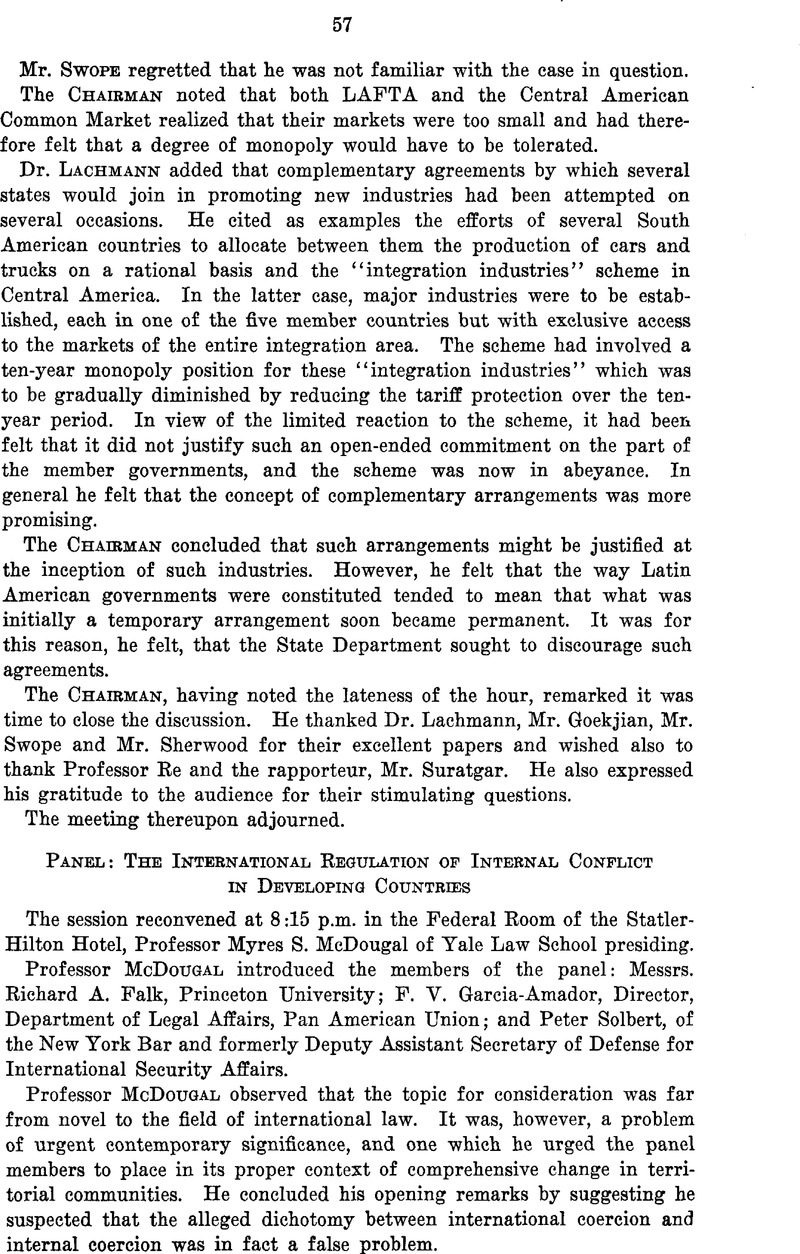No CrossRef data available.
Published online by Cambridge University Press: 27 February 2017

1 Huntington, S. P., ‘ ‘ Patterns of Violence in International Politics'’ in Changing Patterns of Military Politics 17-50, 39 (1962).
2 This approach is most clearly formulated in the Eisenhower Doctrine, embodied in a Joint Resolution of Congress signed by the President on March 9, 1957; see 36 Dept. of State Bulletin 481 (March 25, 1957). Sec. 2 states the major premise: “The President is authorized to undertake, in the general area of the Middle East, military assistance programs with any nation or group of nations of that area desiring such assistance. Furthermore, the United States regards as vital to the national interest and world peace the preservation of the independence and integrity of the nations of the Middle East.To this end, if the President determines the necessity thereof, the United States is prepared to use armed forces to assist any such nation or group of such nations requesting assistance against armed aggression from any country controlled by international communism:Provided, that such employment shall be consonant with the treaty obligations of the United States and with the Constitution of the United States.” (Emphasis added.)
3 Cf.useful system of classification of civil strife proposed by Lincoln P. Bloomfleld in terms of basically internal, externally abetted internal instability, and externally created or controlled internal instability, with a listing of examples under each category, in Bloomfleld, International Military Forces 28-30 (1964).
4 For a pro-Israeli interpretation of the Suez campaign see Julius Stone, Aggression and World Order 1, 99-103 (1958).
5 See C. Neale Bonning, Law and Politics in Inter-American Diplomacy 63-88 (1963).
6 For a recent formulation of the doctrine of non-intervention, see resolution adopted at the 20th Session of the General Assembly, A/EBS/2131 (XX)/Eev. 1, Jan. 14, 1966.
7 See, e.g., Report of the Ad Hoc Congressional Conference on Viet-Nam, Feb. 15,1966.
8 Pearce Higgins, Hall's International Law 347 (8th ed., 1924); this is the apparent conclusion reached by A. J. and Ann Thomas in their comprehensive survey of the relevant doctrine of international law: Non-Intervention—The Law and Its Import in the Americas 215-221 (1956).
9 James W. Garner, “Questions of International Law in the Spanish Civil War,” 31 A.J.I.L. 66 (1937).
10 Vattel, The Law of Nations (1758), Bk. II. $56, p. 131 (Vol. I l l , Classics of International Law, 1916).
11 Falk, “Janus Tormented: The International Law of Internal War,” in James N. Rosenau (ed.), International Aspects of Civil Strife 185-248 (1964).
12 For convenient text see Congressional Record, March 10, 1966, pp. 5274-5279; and 54 Dept. of State Bulletin 474 (March 28, 1966).
13 Cong. Rec. at 5274; eg.factual interpretation in “Peace in Vietnam—A New Approach in Southeast Asia,” A Report Prepared for the American Friends Service Committee, pp. 37-49 (1966).
14 For official documentation on extent of United States reference to the Security- Council on Viet-Nam, see attachment to letter of Douglas MacArthur, II, Feb. 25, 1966, written to Senator Fulbright and reprinted in Hearings Before the Committee on Foreign Relations on S.2793, “Supplemental Foreign Assistance Fiscal Year 1966— Vietnam,” Pt. 1, pp. 634-635 (1966).